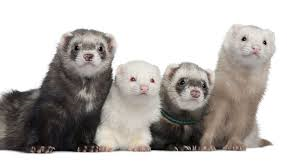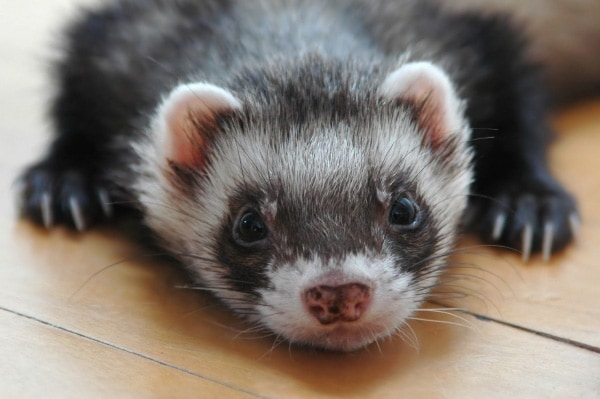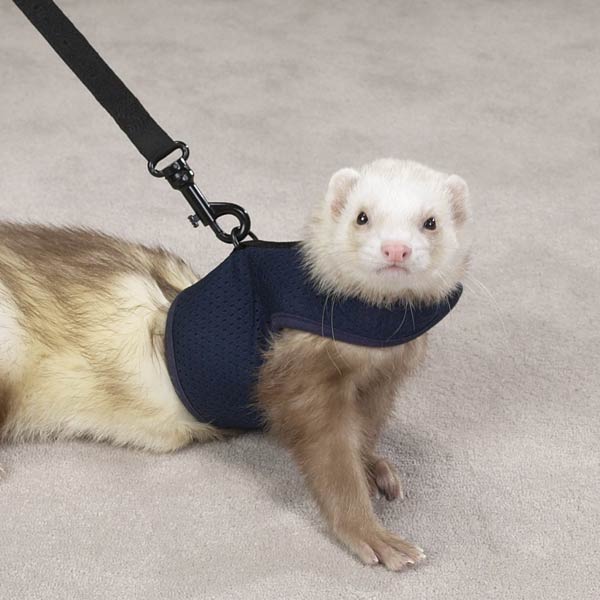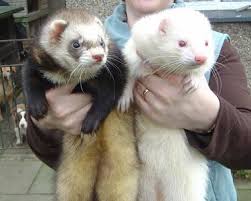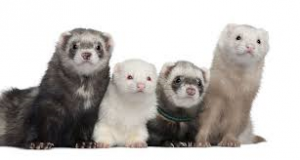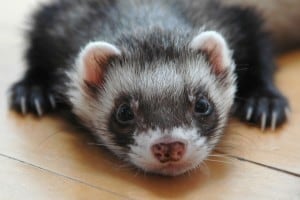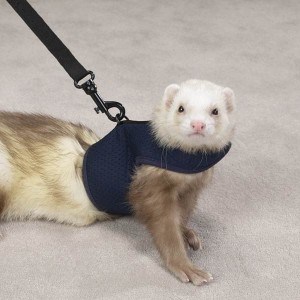Type the name of the breed you're looking for below
[wpdreams_ajaxsearchlite] Don't see the breed your're looking for? Click here and let us know!Ferret
| Origin | The ferret (Mustela putorius furo) is the domesticated form of the European polecat, a mammal belonging to the same genus as the weasel, Mustela of the family Mustelidae. They typically have brown, black, white, or mixed fur. They have an average length of 51 cm (20 inches) including a 13 cm (5 inch) tail, weigh about 1.5–4 pounds (0.7–2 kg), and have a natural lifespan of 7 to 10 years. Ferrets are sexually dimorphic predators with males being substantially larger than females. Several other Mustelids also have the word ferret in their common names, including an endangered species, the black-footed ferret. The name "ferret" is derived from the Latin furittus, meaning "little thief", a likely reference to the common ferret penchant for secreting away small items. The Greek word ictis occurs in a play written by Aristophanes, The Acharnians, in 425 BC. Whether this was a reference to ferrets, polecats, or the similar Egyptian Mongoose is uncertain. The history of the ferret's domestication is uncertain, like that of most other domestic animals, but it is likely that ferrets have been domesticated for at least 2,500 years. They are still used for hunting rabbits in some parts of the world, but increasingly, they are kept only as pets. Being so closely related to polecats, ferrets easily hybridize with them, and this has occasionally resulted in feral colonies of polecat-ferret hybrids that have caused damage to native fauna, especially in New Zealand. As a result, some parts of the world have imposed restrictions on the keeping of ferrets |
| Natural Habitat | European forests. |
| Wild Species | The European polecat (Mustela putorius) — also known as the black or forest polecat (as well as a some other names) — is a species of mustelid native to western Eurasia and North Africa. It is of a generally dark brown colour, with a pale underbelly and a dark mask across the face. Occasionally, colour mutations, including albinos and erythrists, occur. Compared to minks and other weasels — also fellow members of the genus Mustela — the polecat has a shorter, more compact body a more powerfully built skull and dentition, and is less agile. It is much less territorial than other mustelids, with animals of the same sex frequently sharing home ranges. Like other mustelids, the European polecat is polygamous, though pregnancy occurs directly after mating, with no induced ovulation. It usually gives birth in early summer to litters consisting of five to 10 kits, which become independent at the age of two to three months. The European polecat feeds on small rodents, birds, amphibians and reptiles. It occasionally cripples its prey by piercing its brain with its teeth and stores it, still living, in its burrow for future consumption. The European polecat originated in Western Europe during the Middle Pleistocene, with its closest living relatives being the steppe polecat, the black-footed ferret and the European mink. With the two former species, it can produce fertile offspring, though hybrids between it and the latter species tend to be sterile, and are distinguished from their parent species by their larger size and more valuable pelts. The European polecat is the sole ancestor of the ferret, which was domesticated more than 2000 years ago for the purpose of hunting vermin. The species has otherwise been historically viewed negatively by humans. In the British Isles especially, the polecat was persecuted by gamekeepers, and became synonymous with promiscuity in early English literature. During modern times, the polecat is still scantly represented in popular culture when compared to other rare British mammals, and misunderstandings of its behaviour still persist in some rural areas. As of 2008, it is classed by the IUCN as Least Concern due to its wide range and large numbers. |
| History with Humans | Morphological, cytological and molecular studies confirm the European polecat is the sole ancestor of the ferret, thus disproving any connection with the steppe polecat, which was once thought to have contributed to the ferret's creation. Ferrets were first mentioned by Aristophanes in 450 BC and by Aristotle in 350 BC. Greek and Roman writers in the first century AD were the first to attest on the ferret's use in bolting rabbits from their burrows. The first accurate descriptions of ferrets come from Strabo during 200 AD, when ferrets were released onto the Balearic Islands to control rabbit populations. As the European rabbit is native to the Iberian Peninsula and northwest Africa, the European polecat likely was first domesticated in these regions. The ferret and European polecat are similar in both size and portions, to the point that dark-coloured ferrets are almost indistinguishable from their wild cousins, though the ferret's skull has a smaller cranial volume, and has a narrower postorbital constriction. Compared to the European polecat, the ferret has a much smaller brain, though this comparison has not been made with Mediterranean polecats, from which ferrets likely derive. The theory of a Mediterranean origin is further strengthened because the ferret is less tolerant of cold than northern polecat subspecies. The ferret is also more fertile than the polecat, producing two or more litters annually, as opposed to just one. Unlike other subspecies, which are largely solitary, the ferret will readily live in social groups. The ferret is also slower in all its movements than the polecat, and hardly ever makes any use of its anal scent glands. Overall, the ferret represents a neotenous form of polecat. |
| As Pets | Ferrets spend 14–18 hours a day asleep and are most active around the hours of dawn and dusk, meaning they are crepuscular. Unlike their polecat ancestors, which are solitary animals, most ferrets will live happily in social groups. A group of ferrets is commonly referred to as a "business". They are territorial, like to burrow, and prefer to sleep in an enclosed area. Like many other mustelids, ferrets have scent glands near their anus, the secretions from which are used in scent marking. Ferrets can recognize individuals from these anal gland secretions, as well as the sex of unfamiliar individuals. Ferrets may also use urine marking for sex and individual recognition. As with skunks, ferrets can release their anal gland secretions when startled or scared, but the smell is much less potent and dissipates rapidly. Most pet ferrets in the US are sold de-scented (anal glands removed). In many other parts of the world, including the UK and other European countries, de-scenting is considered an unnecessary mutilation. When excited, they may perform a behaviour commonly called the weasel war dance, characterized by a frenzied series of sideways hops, leaps and bumping into nearby objects. Despite its common name, this is not aggressive but is a joyful invitation to play. It is often accompanied by a soft clucking noise, commonly referred to as "dooking". In contrast, when scared, ferrets will make a hissing noise, when upset, makes a soft 'squeaking' noise. Ferrets have a typical Mustelid body-shape being long and slender. Their average length is about 50 cm including a 13-cm tail. They weigh between 0.7 kg to 2.0 kg and are sexually dimorphic as the males are substantially larger than females. The average gestation period is 42 days and females may have 2 or 3 litters each year. The litter size is usually between 3 to 7 kits which are weaned after 3 to 6 weeks and become independent at 3 months. They become sexually mature at approximately 6 months and the average life span is 7 to 10 years. |
| Colour Variations | Most ferrets are either albinos, with white fur and pink eyes, or display the typical dark masked Sable colouration of their wild polecat ancestors. In recent years fancy breeders have produced a wide variety of colours and patterns. Colour refers to the colour of the ferret's guard hairs, undercoat, eyes, and nose; pattern refers to the concentration and distribution of colour on the body, mask, and nose, as well as white markings on the head or feet when present. Some national organizations, such as the American Ferret Association, have attempted to classify these variations in their showing standards. There are four basic colours. The Sable (including chocolate and dark), Albino, Dark Eyed White (DEW), and the silver. All the other colours of a ferret are variations on one of these four categories. Waardenburg-like colouring: Ferrets with a white stripe on their face or a fully white head, primarily blazes, badgers, and pandas, almost certainly carry a congenital defect which shares some similarities to Waardenburg syndrome. This causes, among other things, a cranial deformation in the womb which broadens the skull, white face markings, and also partial or total deafness. It is estimated as many as 75 percent of ferrets with these Waardenburg-like colourings are deaf. White ferrets were favored in the Middle Ages for the ease in seeing them in thick undergrowth. Leonardo da Vinci's painting Lady with an Ermine is likely mislabelled; the animal is probably a ferret, not a stoat, (for which "ermine" is an alternative name for the animal in its white winter coat). Similarly, the Ermine portrait of Queen Elizabeth the First shows her with her pet ferret, which has been decorated with painted-on heraldic ermine spots. |
| Care | Brushing: During the shedding season, your ferret will need to be brushed. If you do not brush your ferret, he/she may get a hairball. You can buy ferret brushes from pretty much any pet store that sells ferret supplies. Nails: You usually need to clip ferret nails about once every two weeks, although it varies from ferret to ferret. You can use regular nail clippers to clip your ferret's nails, or you can use special ferret nail clippers. I use regular. When clipping their nails, watch for the red vein that goes through their nail, do not clip it! Clip a little ahead of this vein. Ears: You will need to clean your ferrets ears about every week. But it varies from ferret to ferret. This can be done with a ferret ear cleaner solution and some Q-tips. Tooth Brushing: Yes, you do have to brush a ferrets teeth. It is literally impossible to "brush" the teeth. I just put some malt flavored cat toothpaste on my finger and rub it on their teeth. The toothpaste gets rid of all the grime on their teeth. |
| Bath Requirements | Choose the right shampoo. Use a shampoo that is safe for ferrets, cats or kittens. Baby shampoo will do too. Do not use dog shampoo: they can contain harsh chemicals safe for dogs, but very harmful to ferrets. Do not use strong shampoos or dish soap either: ferrets need a very gentle shampoo. |
| Housing | Ferret cages are usually designed with two levels and a place to hang a cozy hammock. The cage should also contain a dark enclosure such as a wooden hut, where the ferrets can make a nest for sleeping. Towels and similar fabrics make good bedding. The bedding will need to be washed frequently, and the cage itself will need regular scrubbing. Your ferret needs several litter boxes: one for the cage and several for playtime outside the cage. The best litters to use are shredded paper and newspaper-based cat litters. From time to time, your ferret will need to visit the vet’s office. To transport your ferret safely, you’ll need a pet carrier with gaps small enough that your pet can’t worm his way through them. A leash and H-harness will also be useful. Heavy ceramic bowls are good dishes for ferrets. Expect the playful little pet to up-end the water bowl, however, so supply a sipper bottle as well. |
| Health | The domestic ferret is known to suffer from several distinct ferret health problems. Among the most common are cancers affecting the adrenal glands, pancreas, and lymphatic system. Viral diseases include canine distemper and influenza. Certain health problems have also been linked to ferrets being neutered before sexual maturity was reached. Certain colours of ferret may also carry a genetic defect known as Waardenburg syndrome. Similar to domestic cats, ferrets can also suffer from hairballs and dental problems. Neutering: Like many other carnivores, ferrets have scent glands near their anuses, the secretions from which are used in scent marking. Ferrets recognize other individuals from these anal gland secretions, as well as the sex of unfamiliar individuals. Ferrets may also use urine marking for sex and individual recognitions. Males, if not neutered, are extremely musky. It is considered preferable to delay neutering until sexual maturity has been reached, at approximately six to eight months old, after the full descent of the testicles. Neutering the male will reduce the smell to almost nothing. The same applies for females, but spaying them is also important for their own health. Unless they are going to be used for breeding purposes, female ferrets will go into extended heat and a female that will not mate, without medical intervention, can die of aplastic anemia. It is possible to use a vasectomised male to take a female out of heat. Due to speculation on the possible effects of the photoperiod effect on the ferret's adrenal gland, some owners prefer to house their pets outdoors in sheds, and not indoors. Hairballs: Hairballs can occur in ferrets, but are not readily expelled by vomiting like the way cats deal with them. One or more hairballs in a ferret may lead to loss of appetite and subsequent weight loss. A hairball may enter the intestine and cause a life-threatening obstruction. Ferrets typically replace their coats twice a year, and at that time require brushing to remove loose hairs before they can be ingested, and possibly administration of a hairball remedy as a preventive. Artificial lighting or administration of certain medications may alter the normal spring and fall seasonal coat changes in the ferret. |
| Diet | Ferrets are obligate carnivores. The natural diet of their wild ancestors consisted of whole small prey—i.e., meat, organs, bones, skin, feathers, and fur. Ferrets have short digestive systems and quick metabolism, so they need to eat frequently. Prepared dry foods consisting almost entirely of meat (including high-grade cat food, although specialized ferret food is increasingly available and preferable) provide the most nutritional value and are the most convenient, though some ferret owners feed pre-killed or live prey (such as mice and rabbits) to their ferrets to more closely mimic their natural diet. Ferret digestive tracts lack a cecum and the animal is largely unable to digest plant matter. Before much was known about ferret physiology, many breeders and pet stores recommended food like fruit in the ferret diet, but it is now known that such foods are inappropriate, and may in fact have negative ramifications on ferret health. Ferrets imprint on their food at around six months old. This can make introducing new foods to an older ferret a challenge, and even simply changing brands of kibble may meet with resistance from a ferret that has never eaten the food as a kit. It is therefore advisable to expose young ferrets to as many different types and flavors of appropriate food as possible. |
| Dentistry | Ferrets have four types of teeth (the number includes maxillary (upper) and mandibular (lower) teeth): Twelve small teeth (only a couple of millimeters) located between the canines in the front of the mouth. These are known as the incisors and are used for grooming. Four canines used for killing prey. Twelve premolar teeth that the ferret uses to chew food—located at the sides of the mouth, directly behind the canines. The ferret uses these teeth to cut through flesh, using them in a scissors action to cut the meat into digestible chunks. Six molars (two on top and four on the bottom) at the far back of the mouth are used to crush food. Dental calculus (tartar) is a hard substance formed on the teeth from the mineralization of plaque. Dental tartar primarily comes from wet food which get stuck to the teeth for extended periods of time. Tartar can be avoided by ferrets eating raw meat, bones and preferably whole prey. The biomechanics of consuming meat and bones will keep the teeth clean. Left to itself, tartar may lead to gingivitis which in turn can lead to a dental abscess, bone loss, infections which may spread bacteria through the bloodstream to internal organs and lead to death if not treated. Tartar can be removed either mechanical or by ultrasound at a veterinarian (this usually involves anesthesia), a small toothbrush can also be used as a preventive measure if one is unable to feed the animal with raw meat. Tartar can be prevented by feeding raw food or giving specially made gelatin treats for ferrets. Dental abrasion or tooth wear is common in ferrets, and is caused by mechanical wear of the teeth. Eating manufactured dry food (kibble) will erode (due to the hard and extremely dry kibble) the carnassial teeth of the ferret, the wear from the eating kibble can become significant with old age (after three to five years). If teeth are overly ground down, a ferret cannot use them as scissors to eat raw meat. Tooth erosion eventually affects a ferret's ability to eat solid food. Dental abrasion can also be caused by excessive chewing on fabrics or toys, and cage biting. If the ferret engages in these activities a lot, it might be a sign of boredom, and more stimulating activities (such as play) should rectify the situation. |
| Infectious Diseases | A common ailment which can be fatal in ferrets is foot rot, a form of fungal infection which attacks the feet and sometimes spreads to the tail. It initially appears as a small, yellow, scab-like infection. If untreated, it can cover the feet, and later the entire body. Foot rot is normally caused by poor cage hygiene, i.e., excessive feces accumulation. Viral diseases Epizootic catarrhal enteritis (ECE) ECE, a viral disease that first appeared in the northeastern US in 1994, is an inflammation of the mucous membranes in the intestine. The condition manifests itself as severe diarrhea (often of a bright green colour), loss of appetite, and severe weight loss. The virus can be passed via fluids and indirectly between humans. Although it was often fatal when first discovered, ECE is less of a threat today. Ferret systemic coronavirus (FSC) The coronavirus which causes ECE has a counterpart strain that has more systemic effects with a higher mortality rate. This systemic syndrome has been compared to Feline infectious peritonitis in cats. Aleutian disease virus (ADV) Aleutian Disease Virus (ADV) is a parvovirus discovered among mink in the Aleutian Islands in the early 20th century. In ferrets, the virus affects the immune system (causing it to produce non-neutralizing antibodies) and many internal organs, particularly the kidneys. There is no cure or vaccine for the disease, and ferrets may carry the virus for months or years without any signs. Canine distemper Canine distemper (CD) is an extremely contagious virus that is considered always fatal. Being strict indoor pets does not necessarily protect ferrets, as owners may bring the virus home on their clothes or their shoes. The distemper virus is very short-lived in hot, dry weather, but may persist on hands or surfaces for much longer in cool, damp weather. The only protection against the virus is vaccination, but that is not without controversy as there have been reports, particularly from the USA, of ferrets going into anaphylactic shock after being vaccinated against CD. There is some anecdotal evidence that occurrence of a vaccine reaction is related to a low blood sugar level, and that feeding the ferret a sweet paste-type nutritional supplement shortly before the vaccination to raise the blood glucose has reduced the incidence of reactions. A ferret with partial immunity to distemper can be exposed to canine distemper and go through an incubation period of up to six weeks before showing signs of infection, as compared to a few days in an unvaccinated animal. Signs can include runny nose, discharge from the eyes, fever (up to 107 degrees F.), and severe malaise, followed by development of changes in the skin including discolouration and thickening of the nose (a pink nose will develop an orange colouration), measles-like sores on the chin and belly, and thick crusting of the pads of the feet (hyperkeratosis). The discharge is highly contagious to other unvaccinated ferrets and canines. If the ferret survives the initial acute phase of the disease, they will die within a few weeks from a progressive and incurable neurological infection, progressing to severe epileptic seizures and death. Influenza Influenza, essentially the same disease and same agent that occur in humans, is caused by an othomyxovirus that can be passed from ferrets to Humans and from Humans to ferrets. Ferrets have served as experimental animal models in the study of influenza virus. Smith, Andrews, Laidlaw (1933) inoculated ferrets intra-nasally with human naso-pharyngeal washes, which produced a form of influenza that spread to other cage mates. The human influenza virus (Influenza type A) was transmitted from an infected ferret to a junior investigator, from whom it was subsequently re-isolated. The virus usually affects the nasal epithelium but can cause pneumonia. Signs include anorexia, fever, sneezing, nasal and ocular discharges and usually spontaneous recovery in 4 days or less. Antibiotic use can prevent complicating secondary bacterial infections. |

